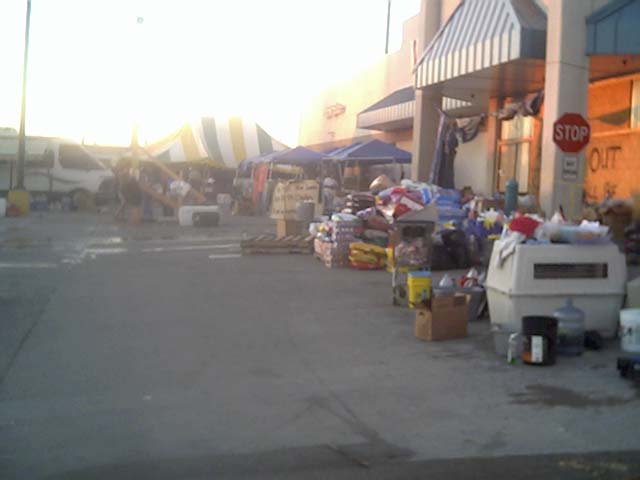WINN-DIXIE STAGING AREA WHERE
WE CONDUCTED OUR FEEDING AND
WATERING AND TRAPPING FROM
My last email resulted in 12 people from 6 states, who cared about the tortuous plight of New Orleans animals, going as a group to bring relief . We were there from Oct 12 until October 22 nd . Sheila Mahon and I were the only two “two-timers.” I pre-shipped 1000 aluminum watering pans and about 30 seven gallon water jugs. We also had a total of 4 trucks/SUVs for our team's assault on Armageddon.
We got there on the last day that Lamar Dixon had any HSUS personnel left. Anne Culver, HSUS Director of Disaster Svcs (who I had worked with and for during my first trip), was saying her goodbye to staffers in a lone trailer. That trailer had kept tens of thousands of animals alive for 6 weeks with the now famous “feeding and watering” operation instituted by the HSUS, Jane Garrison and David Meyers. But now it was obvious that a major transition was occurring -- their feeding and watering operation had come to screeching halt as a result of the HSUS closing down of Lamar Dixon.
Consequently we did not know where we were going to stage our team's re-instatement of the feeding and watering of the city's animals. We rolled into the Winn-Dixie parking lot and instantly felt at home. In the ensuing 10 days our vehicles dropped food and water at almost 1000 locations throughout the city, for the first time reaching many parts of the infamous Ninth Ward and St. Bernard Parrish, which had previously been closed to all but military and police..
Having brought one large dog trap on the plane we began setting the trap on the third day. Plus we borrowed a dog trap which no one else was using. Pretty soon we were bringing in 2-3 dogs a day. Our daily routine was to wake up at 6:30 AM, walk the almost 100 dogs in the kennel area for an hour, load up an SUV with 30 seven gallon water jugs, drive to St Francis Church in downtown N.O. where they had a water purification system strictly for the animals, which we used to get the day's water for distribution in the streets. Return to Winn Dixie and eat a bite (if we remembered to), load up the vehicle with 500 lbs of food, 100 bowls, 50 gallons of water, a dog catch pole, a crowbar, and water for us to drink. Two man teams in each vehicle…one navigator one driver. Have a morning meeting with all four teams and divide up the city into grids and assign a team to feed and water one entire grid each day. Check the traps from the pervious night and collect a dog or two, re-set the traps and start the water and feed drops until dusk, then go back and check the traps again, and collect some more dogs again. Then head back to Winn Dixie to unload and intake the trapped dogs, then walk and feed the kennel dogs, after all this we ate dinner (most of the time). We repeated this for 10 days.
Within a short time we had fed and watered at least 20% of the entire city…in perfect grid pattern, with feed and water stations located at intersections and a trail of cat food leading from the food to the water. Dogs can pick up the smell of cat food from a half mile away.
Our dog trapping operation was so successful that others at Winn Dixie started trapping also toward the end of our stay. I trained half a dozen people how to humanely and effectively use dog traps. I demonstrated on actual feral (if there is such a thing) dogs we caught. I showed how the catch pole can be used humanely and not subjecting the animal to additional anguish. We trapped 14 or 15 dogs (I lost count), half of them purebreds. We were able to find foster homes for all the dogs, even though a couple of them went to Best Friends at Tylertown, MS. In total we removed at least 20 animals from New Orleans and fed and watered hundreds more.
We were privileged to have seen the very best in people. For once in my life I saw hunters and animal rights vegans working hand in hand. Perhaps that should tell all of you who have not yet gone to help just how desperate the situation is for animals in New Orleans. Time is running out very fast as the authorities simply cannot allow the hundreds of packs of dogs roaming the streets to live like that indefinitely.